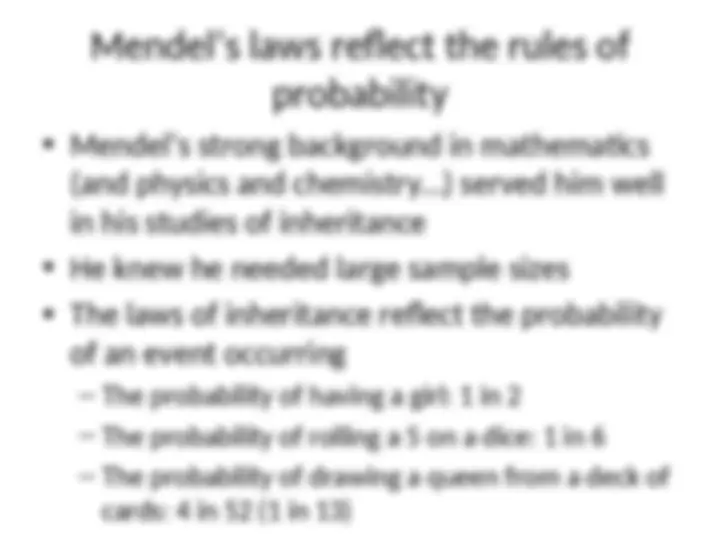Download Genetics: Understanding the Science of Heredity and Mendel's Principles - Prof. Marianne M and more Study notes Biology in PDF only on Docsity!
Genetics
Genetics
- (^) Genetics is the science of heredity
- (^) Genetics explains how genes bring about characteristics in living organisms and how those characteristics are transmitted from parents to offspring
- (^) Genetics is at the center of all biology because gene activity underlies all biological processes!
Experimental Genetics
- (^) The modern science of genetics began in the 1860’s when Gregor Mendel, an Austrian monk studied the principles of genetics by breeding garden peas - (^) Available in a wide variety of shapes and colors - (^) Cheap and abundant - (^) Short generation times with large amounts of offspring
Experimental Genetics
- (^) Mendel studied 7 characters (heritable features) each with its own distinctive trait (variant of that character)
- (^) He created true-breeding lines; lines of peas that were homologous for each trait - (^) A true breeding line had only the genes that coded for that trait, both chromosomes had the same version of the gene - (^) For example, a true breeding purple pea plant had only ‘purple’ genes, not white
Experimental Genetics
- (^) Mendel wanted to see what happened when he crossed true-breeding lines for one trait with true-breeding lines for another trait
- (^) His results led to the establishment of several principles: - (^) Mendel’s Law of Dominance - (^) Mendel’s Law of Segregation - (^) Mendel’s Law of Independent Assortment
- (^) What would happen if you cross a purple flower with a white flower?
- (^) Mendel’s results indicated that 3 of the 4 flowers produced had purple flowers, while 1 had white
- (^) How?
P plants 1
- 2 (^1) – 2 Genotypic ratio 1 PP : 2 Pp : 1 pp Phenotypic ratio 3 purple : 1 white F 1 plants (hybrids) Gametes Genetic makeup (alleles) All All Pp Sperm PP p Pp pp Pp P P^ p P^ p P p PP pp All Gametes F 2 plants
Mendel’s Law of Dominance
- (^) For each character, an organism inherits 2 alleles, 1 from each parent
- (^) These alleles may be the same or different
- (^) An organism that has 2 identical alleles for a gene is said to be homozygous
- (^) An organism that has 2 different alleles for a gene is said to be heterozygous
Mendel’s Law of Segregation
- (^) A sperm or egg carries only 1 allele for each inherited character
- (^) This is because allele pairs segregate (separate) during gamete formation (meiosis!)
- (^) When sperm and egg unite during fertilization, they each contribute their own allele, restoring the paired ‘condition’ to the offspring
Mendel’s Law of Independent
Assortment
- (^) The alleles of a gene pair separate from one another independently of the other alleles of another gene pair during segregation (meiosis)
- (^) The origin of any particular allele will be randomly selected from paternal or maternal chromosomes via the process of crossing-over (why, for example, a cat’s color is independent of its tail length)
(^1) – 4 (^1) – 4 (^1) – 4 (^1) – 4 (^1) – 4 (^1) – 4 (^1) – 4 (^1) – 4 ––^9 16 ––^3 16 ––^3 16 ––^1 16 Sperm Gametes RRYY rryy RrYy RY ry RRYY rryy RrYy ry RY RrYy RrYy RrYy RrYY rrYY RrYY RRYy RRYy rrYy rrYy Rryy Rryy RRyy rY Ry ry Yellow round Green round Green wrinkled Yellow wrinkled RY (^) rY Ry
- (^) In this example, yellow and green are 2 traits for the color character (indicated by Y and y, respectively) and round and wrinkled are 2 traits of another character (indicated by R and r, respectively)
Homozygous for the dominant allele Homozygous for the recessive allele Heterozygous Genotype: P a B P PP a aa b Bb
Genetics terminology
- (^) The complete genetic make-up of an organism is called its genotype
- (^) The physical expression of the genotype is its phenotype
Phenotypes can reveal genotypes
- (^) How can you determine your dog’s genotype (without a blood test)?
- (^) You can testcross your dog; mating your dog with a homozygous recessive dog (bb; a chocolate lab)
- (^) If the black lab was BB, all of its offspring will be black (Bb)
- (^) If the black lab was Bb, half would be black (Bb) and half would be brown (bb)
B_ or Two possibilities for the black dog: Testcross: Genotypes Gametes Offspring (^) All black 1 black : 1 chocolate Bb bb BB Bb bb B b Bb b B b
































































































